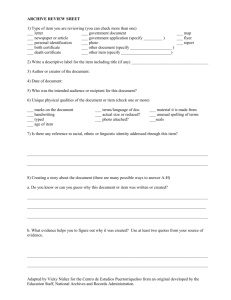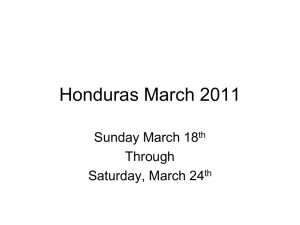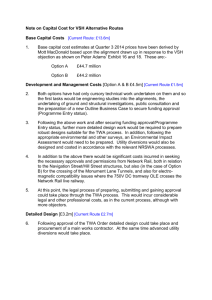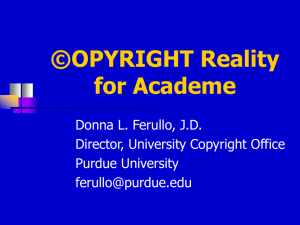RE MIDLAND METRO (BIRMINGHAM CITY CENTRE LAND
advertisement
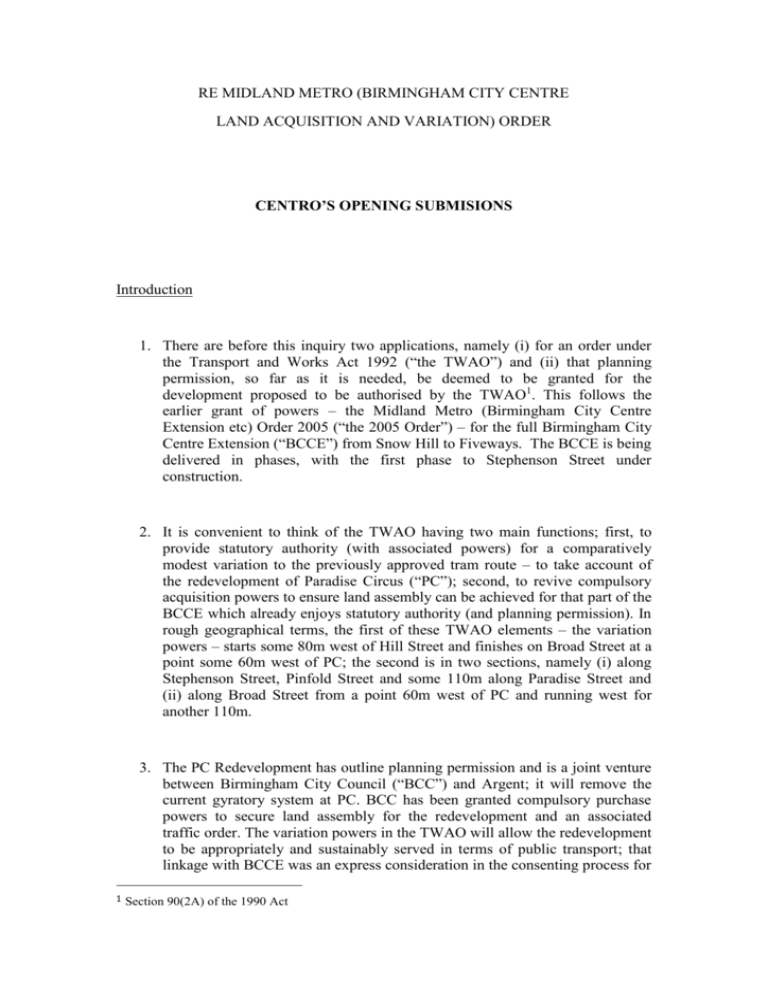
RE MIDLAND METRO (BIRMINGHAM CITY CENTRE LAND ACQUISITION AND VARIATION) ORDER CENTRO’S OPENING SUBMISIONS Introduction 1. There are before this inquiry two applications, namely (i) for an order under the Transport and Works Act 1992 (“the TWAO”) and (ii) that planning permission, so far as it is needed, be deemed to be granted for the development proposed to be authorised by the TWAO1. This follows the earlier grant of powers – the Midland Metro (Birmingham City Centre Extension etc) Order 2005 (“the 2005 Order”) – for the full Birmingham City Centre Extension (“BCCE”) from Snow Hill to Fiveways. The BCCE is being delivered in phases, with the first phase to Stephenson Street under construction. 2. It is convenient to think of the TWAO having two main functions; first, to provide statutory authority (with associated powers) for a comparatively modest variation to the previously approved tram route – to take account of the redevelopment of Paradise Circus (“PC”); second, to revive compulsory acquisition powers to ensure land assembly can be achieved for that part of the BCCE which already enjoys statutory authority (and planning permission). In rough geographical terms, the first of these TWAO elements – the variation powers – starts some 80m west of Hill Street and finishes on Broad Street at a point some 60m west of PC; the second is in two sections, namely (i) along Stephenson Street, Pinfold Street and some 110m along Paradise Street and (ii) along Broad Street from a point 60m west of PC and running west for another 110m. 3. The PC Redevelopment has outline planning permission and is a joint venture between Birmingham City Council (“BCC”) and Argent; it will remove the current gyratory system at PC. BCC has been granted compulsory purchase powers to secure land assembly for the redevelopment and an associated traffic order. The variation powers in the TWAO will allow the redevelopment to be appropriately and sustainably served in terms of public transport; that linkage with BCCE was an express consideration in the consenting process for 1 Section 90(2A) of the 1990 Act the PC Redevelopment. As Mr Adams explains2, the PC developers are contributing, pursuant to a section 106 agreement, to the Variation scheme. 4. No objector to the TWAO remains other than Objector 11, Victoria Square House (“VSH”). VSH’s property lies well to the east of the new powers sought in the TWAO. It appears VSH acquired the freehold of the property at the end of January 20143. 5. Centro has already been granted powers and consents etc which include: a. Statutory power to build the tram on the alignment permitted under the 2005 Order. As noted, the TWAO seeks statutory authority only for the minor variation to take account of the new development at PC – the easternmost extent of those variation powers lies some 80 m west of the junction of Hill Street with Paradise Street; b. Deemed planning permission for development under the 2005 Order4. That deemed permission has been implemented5. Under the TWAO, new deemed planning permission is sought in so far as it does not already exist6. Pursuant to the 2005 deemed planning permission, Centro has also secured detailed consent, including for the area of Pinfold Street7. c. Various listed building consents (“LBC”)8 were granted in 2005, including consent to fix overhead electrification brackets to VSH. These have lapsed. Where and as necessary, fresh applications will be made to Birmingham City Council (“BCC”). d. Compulsory purchase powers, including in respect of VSH, were similarly granted in 2005. These too have lapsed. The TWAO seeks to re-new such powers, in so far as the land/interest required remains the 2 Adams Proof paragraph 5.25 and section 7 Letter of 5th February 2014 from MMS withdrawing objection of previous freeholder of VSH property 4 Ellingham Exhibits 1 and 2 5 Confirmed by letter from Birmingham City Council dated 21 st June 2010 – Adams Exhibit 4 6 MMD 4.5J 7 Ellingham Exhibit 3 8 Adams Exhibit 3 3 2 same and seeks new powers where the alignment change around Paradise Circus (“PCR”) so requires. e. Building agreements, re fixing of the catenary system etc to the building, were entered into with previous freeholders, including with the then freeholders of the property purchased by VSH in 20149. 6. And; a. As noted, BCC has granted consent for the PC Redevelopment, having had express regard to the ability of the BCCE, with the variation, to serve that development. b. The alignment of Midland Metro along the 2005 route is expressly supported by the development plan, with the proposals map10 showing, inter alia, the route running along Stephenson Street and up Pinfold Street past VSH’s property. 7. This Opening seeks to follow the matters raised by the Secretary of State as being matters about which he wishes to be informed (“the SofM”). This Opening does not, for the most part, seek to anticipate – at least not to any great extent - the evidence to be called. Mr Adams produces, as an aide memoire, a Table11 summarising where the various matters are covered in the evidence from Centro; that Table encapsulates the position when proofs were finalised and does not, for example, include cross-reference to Rebuttal Proofs. SofM 1 – The objectives of the TWA Order in the context of the proposed Centenary Square Extension (“CSQ” and “CSQE”) of the Midland Metro Light Rapid Transit System 8. The objectives of the TWAO are variously identified, including in section 4 of the Centro Statement of Case and the Concise Statement of Aims12; these have regard to the changes at PCR and identify the aims of the variation proposal. 9 Adams Exhibits 14 and 15 Ellingham Exhibit 6 11 Adams proof Table 12.1 at page 25 12 MMD/0.1 and MMD/3.4 10 3 BCC supports and endorses the ability of the promoted scheme to achieve the relevant aims and objectives13 SofM 2 – The need and justification for renewing the compulsory acquisition powers for the CSQE previously conferred by the Midland Metro (Birmingham City Centre Extension etc) Order 2005 (“the 2005 Order”) and for varying the tramway alignment authorised by the 2005 Order 9. The need and justification for the BCCE have been clearly established over the years and accepted by, amongst others, the SofS and BCC. The rationale underlying the PC Redevelopment and its inter-relationship with the BCCE has emerged more recently but still over a period of years; it too has been accepted by, amongst others, BCC. The 2005 alignment and route, incorporating the proposed minor variation, represents the appropriate case to progress. 10. This will be covered primarily by Messrs Adams, Chadwick and Ellingham. SofM 3 – The alternative alignment options in Paradise Circus considered by Centro Preliminary 11. In circumstances where the BCCE route and alignment have been endorsed and granted powers, the issue of variation arises only in so far as a limited deviation from that line is sought in the immediate vicinity of PC. The revival of compulsory acquisition powers does not alter this. Alternative alignment options in PC 12. These have been clearly set out and considered, including in the ES supporting the TWAO. In so far as these matters are capable of serious challenge, Messrs Adams, Chadwick and Ellingham will deal with them, supported, on engineering matters by Mr Last. Alternatives as raised by VSH 13 BCC letter of 20.x.14 at page 3 – SUPP/1 4 13. VSH acquired the property in January 2014, in the full knowledge of the TWAO proposal. Neither it, nor the previous freeholders, raised any issue of alternatives in their original objections to the TWAO. Indeed, the first clear glimpse of VSH’s objection is gleaned from its Statement of Case which asserts there are at least two variants in addition to that authorised under the 2005 Order (as proposed to be varied by the TWAO), namely (i) along Navigation Street and Suffolk Street Queensway and (ii) along Navigation Street, Hill Street and Paradise Street. Even ignoring engineering considerations, these alternatives perform materially less well overall than that within the TWAO. BCC concurs, stating14: [BCC] ..is aware of the objection by VSH Nominee 1 Limited and VSH Nominee 2 Limited and does not support the view that there are more suitable alternative routes. I refer you to our current and emerging Development Plan where the associated plans clearly demonstrate the Council’s support for the 205 Order alignment along Pinfold Street and through Victoria Square. The City Council would strongly oppose these alternative routes should they be taken forward. 14. Centro’s witnesses have set out their responses, and will answer questions, on this in so far as the issue lies within their area of expertise. SofM 4 – The extent to which the objectives of the TWA Order are consistent with national, regional and local transportation policies, the National Planning Policy Framework (“the NPPF”) and local planning policies Preliminary 15. It is difficult to envisage how this proposal could be anything other than compliant with the relevant policy matrix. Indeed, this is not only Centro’s view but one which has been endorsed by others including central and local Government. Centro further notes the clear, and independent, view recently expressed by BCC; BCC’s support for adherence to the 2005 alignment in the area of Pinfold Street and its accord with the present and emerging development plan has been noted above. As regards the variation to accommodate the PC Redevelopment, BCC states15: 14 15 SUPP/1 ibid 5 Centro’s proposals to amend the alignment of the 2005 Order for the extension at Paradise Circus were developed in close co-operation with the City Council and offer the benefits of cost saving and a significant reduction in construction disruption due to the combination of the Metro works with the Paradise Circus Redevelopment (PCR) highway works. As you know this joint working and desire to integrate the two very important projects was reflected in the Council’s determination of the outline planning approval for the PCR development. I refer you specifically to the Council’s Planning Committee Report dated 20 December 2012. The PCR development and associated highway works are progressing well and the developer has now satisfactorily discharged the first batch of planning conditions, with the intention for enabling works starting in January 2015. 16. The policy matrix is dealt with in the evidence of Centro’s witnesses, particularly Messrs Adams and Ellingham. It is not necessary to go further in Opening, other than to flag a couple of points in respect of the approach to national and development plan policy. National and regional policy 17. The content of Government policy is not an appropriate subject for discussion and review at a pubic inquiry; the inquiry’s role is, rather, to apply such policy16. Self-evidently, no policy can transmute an immaterial consideration into a material one, or vice versa. The policy-maker is not bound slavishly to follow his/her/its own policy – but any departure from such policy must be justified by clear and cogent reasons17. Development plan 18. Section 38(6) of the 2004 Act provides: If regard is to be had to the development plan for the purpose of any determination to be made under the planning Acts the determination must be made in accordance with the plan unless material considerations indicate otherwise. 16 17 Bushell v SoSE [1980] 2 All ER 608 HL Gransden v SoSE [1986] JPL 519, at 521; upheld at [1997] JPL 365 6 Whilst it would appear that section 38(6) is not strictly engaged here (see Annex hereto), the development plan remains a most material consideration. In practice, the approach set out in that section still falls to be applied. 19. The NPPF took immediate effect and provides: 211. For the purposes of decision-taking, the policies in the Local Plan … should not be considered out-of-date simply because they were adopted prior to the publication of this Framework. 212. However, the policies contained in this Framework are material considerations which local planning authorities should take into account from the day of its publication. The Framework must also be taken into account in the preparation of plans. 213. Plans may therefore need to be revised to take into account the policies in this Framework. This should be progressed as quickly as possible, either through a partial review or by preparing a new plan. 214. For 12 months from the day of publication, decision-takers may continue to give full weight to relevant policies adopted since 2004 even if there is a limited degree of conflict with this Framework. 215. In other cases and following this 12-month period, due weight should be given to other relevant policies in existing plans according to the degree of consistency with this framework (the closer the policies in the plan to the policies in this Framework, the greater the weight they may be give). 20. Here, subject to the modest variation, the proposal is wholly compliant with the present and emerging development plan; and the variation represents an other material consideration which is wholly supported by BCC. 21. The courts have confirmed18 that, in the context of the old section 54A of the Town and Country Planning Act 1990 (and, by parity of logic, one presumes, section 38(6) of the 2004 Act), it is necessary to read the development plan as a whole. It must also be read in the context of subsequent policy and legislative intervention. As a matter of common sense, and legal approach, the courts have recognised that development of any scale may well conflict with some plan policies; indeed, there may well be tensions between different policies. In such circumstances, the correct approach is to identify the 18 R v Rochdale MBC ex p Milne 31st July 2000 at paragraphs 48 to 49; R (Cummins) v Camden LBC [2001] EWHC 1116 (Admin) at paras 163 et seq 7 dominant policy or theme. On any reasonable analysis, that overall dominant theme or policy matrix here is that relating to bringing forward the BCCE. The test is whether, having regard to that, the proposal accords with that plan as a whole; thus any conflict or tension with other policies does not preclude such overall accord. In any event, the various material considerations here militate decisively in favour or the order being made and planning permission deemed granted. SofM 5 – The likely environmental impacts of constructing and operating the revised tram alignment 22. It is neither necessary nor helpful to anticipate the evidence on these matters at this stage. It is sufficient to refer to the ES and the evidence generally. 23. By way of aside, Centro notes that VSH has specified no noise and vibration objection and has not adduced any evidence on this aspect. Yet the VSH timeestimate posits a need to call Mr Monk Steel – instead of taking his evidence as a written statement – and proposes two hours cross-examination for him. It would clearly be helpful were VSH to identify precisely what its case might be in this respect. SofM 6 – The measures proposed by Centro to mitigate any adverse impacts of the proposals in the TWA Order, including any measures to avoid, reduce or remedy any major or significant adverse environmental impacts of the proposals; and whether any adverse environmental impacts would remain after the proposed mitigation 24. This is dealt with in the ES and summarised by Mr Ellingham. SofM 7 – The adequacy of the Environmental Statement submitted with the application for the TWA Order, having regard to the requirements of the Transport and Works (Applications and Objections Procedure) (England and Wales) Rules 2006 and whether the statutory provisions have been complied with. 25. The ES is fit for purpose; Centro notes that no request for Further Information has been made by the SofS. It should be noted that the SofS here gave a 8 Scoping Opinion19 and the ES thus needed only to include the information specified in that Opinion20. 26. It is far from clear whether the one remaining objector advances any suggestion that, in order for the ES to constitute an environmental statement, additional information is required. Even were such a case now to be advanced and were the SofS then, contrary to Centro’s primary case, to conclude that such additional information was indeed required, the SofS would then be under a duty so to indicate and to afford Centro sufficient time to respond by producing the additional information21. SofM 8 – To the extent that objections made by owners and occupiers of land that would be affected by the proposals in the TWA Order have not been withdrawn, the likely impact of those proposals on the property interests concerned 27. Centro has had some difficulty fully understanding whence spring VSH’s concerns. 28. In so far as possible Cento has sought to set out its position in the proofs (including rebuttal) of its witnesses. SofM 9 – Whether the tests in paragraphs 16 to 23 of ODPM Circular 06/2004, which gives guidance on the making of compulsory purchase orders, are satisfied; in particular, whether there is a compelling case in the public interest for conferring on Centro powers compulsorily to acquire an use land for the purposes of the CSQE and whether there are likely to be any impediments to the implementation of the powers in the TWA Order 29. I make the following points - figures in brackets refer to the relevant paragraph number in the Circular: a. Centro is required to justify its compulsory acquisition proposals but has discretion how best to do that (16). 19 By letter dated 14.v.13 - ES at 2C – MMD/ Rule 11(3) T & W (Applications and Objections Procedure) (E & W) Rules 2006 21 Ibid Rule 17 20 9 b. By whatever route a compelling case in the public interest must be shown (17). c. The SofS must be able to take a balanced view between Centro’s intentions and the concerns of those whose land or interest is to be acquired (18). d. Centro must be able to show a clear idea of how it intends to use the land and that the necessary resources are likely to be available to achieve the end within a reasonable timescale. The public benefit must outweigh any private loss (19). e. Centro needs to provide as much information as possible about the resource implications of implementing the scheme (20). f. The timing of funding’s being available – including to cover any blight - is also relevant (21). g. Centro needs to show a reasonable prospect of the scheme’s going ahead, including that it is unlikely to be blocked by any impediments – in addition to funding/financial these include physical and legal factors such as need for other consent(s), permission(s) or licence(s) and any accommodation or remedial works (22 and 23). 30. In Centro’s submission, its evidence satisfies all these points. SofM 10 – Having regard to section 25 of the TWA, whether the relevant Crown authority has agreed to the compulsory acquisition of interests in, and/or the application of provisions in the TWA Order in relation to, Crown Land identified in the book of reference 31. The Book of reference erroneously indicates acquisition of a small amount of land from the SofS for Business, Innovation and Skills22. Centro has no need to acquire any land or rights from the SofS and is putting forward a modest amendment to the TWAO to deal with this point. 22 See Adams Proof Appendix B for full explanation. 10 SofM 11 – Centro’s proposals for funding the cost of CSQE 32. Mr Adams explains this in his evidence23. SofM 12 – the conditions proposed to be attached to the deemed planning permission for the revised tramway alignment, if given, and in particular whether those conditions satisfy the six tests referred to in Planning Practice Guidance, Use of Conditions (Section ID:21a) 33. Centro has identified draft conditions in its application for deemed planning permission24. These will no doubt be subject to further discussion as appropriate during the inquiry, probably in a dedicated planning-condition session. SofM 13 – The purpose and effect of any substantive changes proposed by Centro to the TWA Order since the application was made, and whether anyone whose interests are likely to be affected by such changes have [sic] been notified 34. See under SofM 10 above. With this exception, no substantive change is proposed. [SofM 14 – Any other matters which may be considered relevant] 35. There is at present nothing Centro need mention under this head. Conclusion 36. Centro commends this scheme to the Inspector and to the SofS. 23 24 Adams Proof section 5 MMD/4.5J 11 Francis Taylor Building Temple ANDREW NEWCOMBE QC 19th November 2014 12 ANNEX - INITIAL LEGAL SUBMISSIONS Preliminary 1. This Annex sketches various points of law for the avoidance of doubt. In so far as appropriate or necessary, it will be updated. Section 38(6) of the Planning and Compulsory Purchase Act 2004 (“Section 38(6)”) 2. Section 38(6) requires that, in so far as regard is to be had to the development plan, any determination to be made under the planning Acts must be made in accordance with the plan unless material considerations indicate otherwise. 3. The courts have held25 that section 38(6) is not engaged when considering an applications under section 37 of the Electricity Act 1989 (consent for a electricity lines) and section 90(2) of the 1990 Act (deemed planning consent therefore). By parity of reasoning it would appear that the same approach would apply here under section 90(2A). But, in practice, that approach remains a most material consideration and should, in Centro’s submission, be followed. The Planning (Listed Buildings etc) Act 1990 (“the LB Act”) 4. Notwithstanding any scope for parallel arguments re whether sections 66(1) and 72 of the LB Act are engaged Centro submits that matters should be considered on the basis of their applying with full force. 25 Samuel Smith v SofS [2012] EWHC 46 (Admin)

